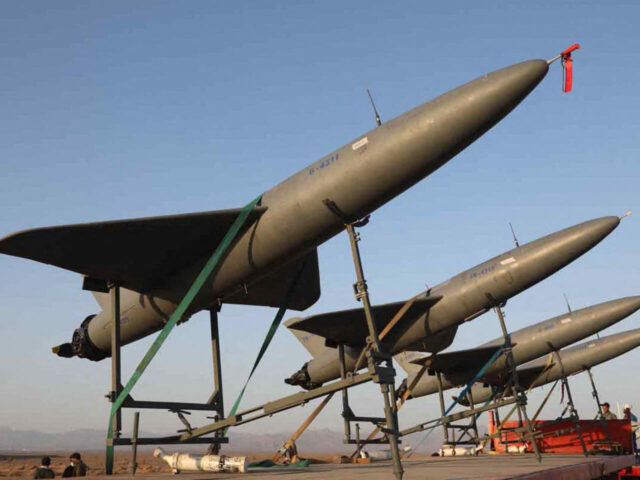
The Strategic Implications of an Iranian Drone Production Facility in Russia
Publication: Eurasia Daily Monitor Volume: 20 Issue: 38
By:

Over the past few weeks, media reports have proliferated that Tehran is gearing up to build a joint drone production plant in Russia (Euromaidan Press, February 6). According to the reports, Western intelligence believes that the production plant in question is part of a $1 billion defense deal recently signed between Moscow and Tehran (Iran International, February 5). Both sides have denied the existence of such a project (Business Gazeta, February 8), and Russian presidential spokesperson Dmitry Peskov stated that Russia has its “own [arms] development programs” (Oreanda News, February 6). Yet, known for its extensive use of maskirovka—masking and military deception—Russia’s, and for that matter Iran’s, word should not be taken at face value. In fact, despite previous claims to the contrary, Iranian kamikaze drones have been flowing into the hands of the Russian Armed Forces and are being used to terrorize innocent Ukrainian civilians. The development of a joint drone production facility would cement Russian-Iranian defense relations even further, potentially leading to a full-fledged partnership underscored by deepened military cooperation.
Since the fall of last year, the Russian Armed Forces have actively resorted to Iranian kamikaze drones to destroy Ukraine’s critical infrastructure (Kyiv Independent, October 26, 2022). Recently, reports have spread that Russian stocks of Iranian drones are running low (Unian, 17 February). Even so, it seems that the burgeoning anti-Western bloc is considering more long-term alternatives to keep the West at bay in the ongoing war—and a joint drone factory represents one of the most feasible options in this regard.
Such a scenario would grant Russia easier access to a continuous stream of Iranian kamikaze drones, which would increase pressure on Ukraine’s air defense systems and military personnel. If materialized, the opening of an Iranian drone facility in the imminent neighborhood of the North Atlantic Treaty Organization (NATO) will also have immense strategic implications, such as bringing a major strategic rival’s military complexes to the Alliance’s doorstep. Besides strengthening the growing military cooperation between Tehran and Moscow, such a development would also pose a great danger to the future security of NATO’s eastern flank with long-term repercussions.
If the plan is indeed implemented, the drone plant in question will become the newest addition to Tehran’s sprawling global production network, which includes facilities in Tajikistan, Syria and Venezuela, among others. Open-source intelligence suggests that the facility will probably be located in the town of Yelabuga, east of Moscow (Gazeta.ru, February 5). With a planned production capacity of around 6,000 Iranian drones per year, the factory will be a true force multiplier in sustaining Russia’s war against Ukraine for the coming months. It will also offer an additional boost to a potential offensive in spring (Gazeta.ru, February 5).
Construction of a production plant will also be much more sustainable than the frequent drone transfers in a highly dangerous and logistically challenging hot zone. The facility can provide Russia with key strategic benefits, such as easy access to spare parts and maintenance support. Remarkably, the proposed site for the production facility, Yelabuga, is near the Kama River. In this regard, the Iranian military complexes present an interesting trend. Some of Tehran’s most critical missile production facilities (including the ones in Parchin and in Baniyas) are all located near a water supply (Radio Free Europe/Radio Liberty, August 16, 2017; Iran International, May 26, 2022). Therefore, albeit still early, the planned production facility could also become a potential new spot for Iranian missile production.
Another influential aspect in terms of strategic implications is the consideration of which drones will be produced at this joint facility. The production plant might initially produce the infamous Shahed-136 and Shahed-131 kamikaze drones already being used in Ukraine. However, the real worry is that the production line could include renewed, modified versions of these drones, which will equip these unmanned aerial vehicles with a higher speed and longer range. Some sources state that the Iranians have already embarked on this journey, by modifying the traditional Shahed-131s to include more destructive warheads (Eurasian Times, February 10). If accomplished, these plans could transform Iranian drones into a broader threat on NATO’s eastern flank, which is no longer contained to only Ukraine.
The facility in question would also grant Tehran an expanded network of suppliers. In truth, despite Western sanctions, Russia still has several supply channels open. Since the outset of the war, some shadow companies in the South Caucasus (e.g., Armenia) and in China have facilitated the circumvention of sanctions for the Kremlin (Eurasianet, March 10, 2022). According to US intelligence, these channels have provided the Russian defense technology industrial base with semi-conductors and sub-components for critical systems. Therefore, the West should keep in mind that, in case of a production agreement with Iran, these countries will also become indirectly complicit in Tehran’s drone development program.
In addition, with an increased presence on NATO’s doorstep, this would mean that Tehran will have easier access and exposure to some of the West’s most sophisticated systems being downed in Ukraine. Sooner or later, this could become an alarming threat that would directly challenge the Alliance’s technological edge, military-technical know-how and intellectual property rights.



